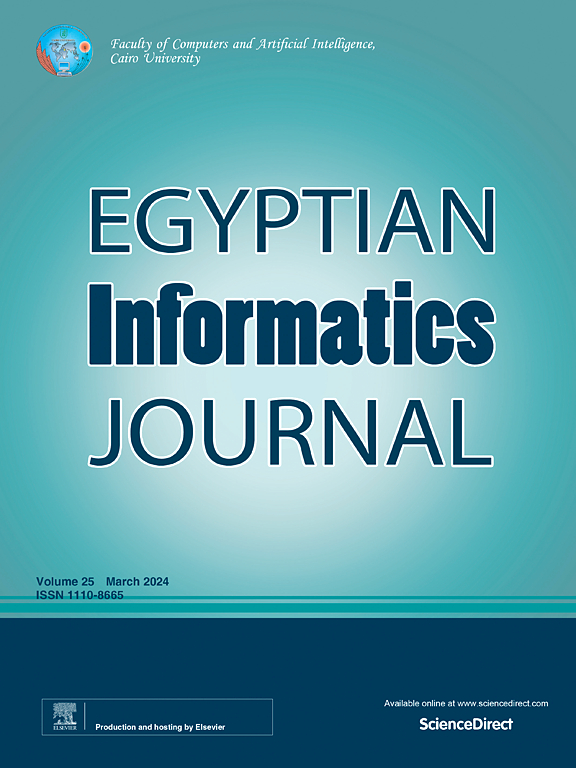Intelligent SDN to enhance security in IoT networks
IF 5
3区 计算机科学
Q1 COMPUTER SCIENCE, ARTIFICIAL INTELLIGENCE
引用次数: 0
Abstract
Software-defined networking (SDN) is a revolutionary technology that has revolutionised network management by providing flexibility and adaptability. As the popularity of SDN increases, it is crucial to address security vulnerabilities in these dynamic networks. This paper proposes a framework for enhancing security in SDN by utilising three separate Deep Learning models, namely Deep Neural Network (DNN), Convolutional Neural Network (CNN), and Long Short-Term Memory (LSTM). This framework is utilised for the InSDN dataset, a huge dataset specifically created for SDN security research. The dataset consists of a total of 343,939 instances, encompassing both normal and attack traffic. The regular data yields a sum of 68,424, whereas the attack traffic comprises 275,515 occurrences. This study employs multiclassification algorithms to precisely detect and categorise diverse security threats in SDN. The InSDN dataset faces issues related to class imbalance, which are addressed by using the Synthetic Minority Over-sampling Technique (SMOTE). The SMOTE technique is utilised to create artificial instances of the underrepresented class, hence achieving a more equitable distribution of security hazards within the dataset. This strategy improves the efficacy of multiclassification techniques, ultimately resulting in greater accuracy in the identification and classification of different security threats in SDN environments. The initial DNN model exhibited satisfactory performance, with an accuracy of 87%. The second CNN model demonstrated strong and consistent performance, with an accuracy rate of 99%. In addition, an LSTM model attained a 90% accuracy rate.
智能 SDN 提高物联网网络的安全性
软件定义网络(SDN)是一项革命性技术,通过提供灵活性和适应性彻底改变了网络管理。随着 SDN 的普及,解决这些动态网络中的安全漏洞至关重要。本文提出了一个框架,通过利用三个独立的深度学习模型(即深度神经网络(DNN)、卷积神经网络(CNN)和长短期记忆(LSTM))来增强 SDN 的安全性。该框架用于 InSDN 数据集,这是一个专为 SDN 安全研究而创建的庞大数据集。该数据集由 343,939 个实例组成,包括正常流量和攻击流量。正常数据的总和为 68,424 次,而攻击流量包括 275,515 次。本研究采用了多分类算法来精确检测和分类 SDN 中的各种安全威胁。InSDN 数据集面临着与类不平衡相关的问题,通过使用合成少数群体过度采样技术(SMOTE)解决了这些问题。SMOTE 技术用于创建代表性不足类别的人工实例,从而在数据集中实现更公平的安全隐患分布。这一策略提高了多分类技术的功效,最终提高了在 SDN 环境中识别和分类不同安全威胁的准确性。最初的 DNN 模型表现令人满意,准确率达到 87%。第二个 CNN 模型表现出强大而稳定的性能,准确率达到 99%。此外,LSTM 模型的准确率也达到了 90%。
本文章由计算机程序翻译,如有差异,请以英文原文为准。
求助全文
约1分钟内获得全文
求助全文
来源期刊

Egyptian Informatics Journal
Decision Sciences-Management Science and Operations Research
CiteScore
11.10
自引率
1.90%
发文量
59
审稿时长
110 days
期刊介绍:
The Egyptian Informatics Journal is published by the Faculty of Computers and Artificial Intelligence, Cairo University. This Journal provides a forum for the state-of-the-art research and development in the fields of computing, including computer sciences, information technologies, information systems, operations research and decision support. Innovative and not-previously-published work in subjects covered by the Journal is encouraged to be submitted, whether from academic, research or commercial sources.
 求助内容:
求助内容: 应助结果提醒方式:
应助结果提醒方式:


